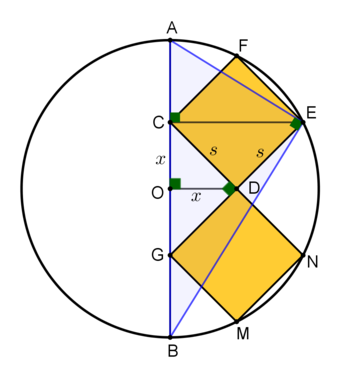Missing Radius
If the radius of the circle shown in the figure is
R
, find the value of
⌊
R
⌋
.

To clarify: The sum of areas of the two yellow squares is 2021.
The answer is 50.
This section requires Javascript.
You are seeing this because something didn't load right. We suggest you, (a) try
refreshing the page, (b) enabling javascript if it is disabled on your browser and,
finally, (c)
loading the
non-javascript version of this page
. We're sorry about the hassle.
3 solutions
 Following the labelling of the figure, denote
O
D
and
C
D
by
x
and
s
respectively.
Following the labelling of the figure, denote
O
D
and
C
D
by
x
and
s
respectively.
Obviously, the two squares are congruent, since
△
C
D
G
is isosceles, thus
s
2
=
2
2
0
2
1
.
By Pythagoras’s theorem on right triangles
△
O
C
D
,
△
C
D
E
we have
2
x
2
=
s
2
and
C
E
2
=
2
s
2
Moreover,
△
A
E
B
is a right triangle as well and
C
E
is its height on the hypotenuse, thus
C E 2 = C A ⋅ C B ⇒ 2 s 2 = ( R − x ) ⋅ ( R + x ) ⇒ 2 s 2 = R 2 − x 2 ⇒ R 2 = 2 s 2 + 2 s 2 ⇒ R 2 = 2 5 s 2 ⇒ R 2 = 2 5 ⋅ 2 2 0 2 1 ⇒ R = 2 1 0 1 0 5 ≈ 50 .26 For the answer, ⌊ R ⌋ = 5 0 .
Let the side of square is a :
a R ∴ ⌊ R ⌋ = 2 2 0 2 1 = ( 2 a ) 2 + ( 2 a ) 2 = 2 5 a = 2 5 2 2 0 2 1 ≈ 5 0 . 2 6 = 5 0
Label the diagram as follows:
Let the sides of each square be s = C D = B C . Since △ A C D is a right isosceles triangle, A C = 2 s .
By the law of cosines on △ A B C , A B 2 = B C 2 + A C 2 − 2 ⋅ B C ⋅ A C ⋅ cos 1 3 5 ° , or R 2 = s 2 + ( 2 s ) 2 − 2 ⋅ s ⋅ 2 s ⋅ ( − 2 1 ) , or R = 4 5 ⋅ 2 s 2 .
Since the area of both square is 2 0 2 1 , 2 s 2 = 2 0 2 1 , so ⌊ R ⌋ = ⌊ 4 5 ⋅ 2 0 2 1 ⌋ = 5 0 .